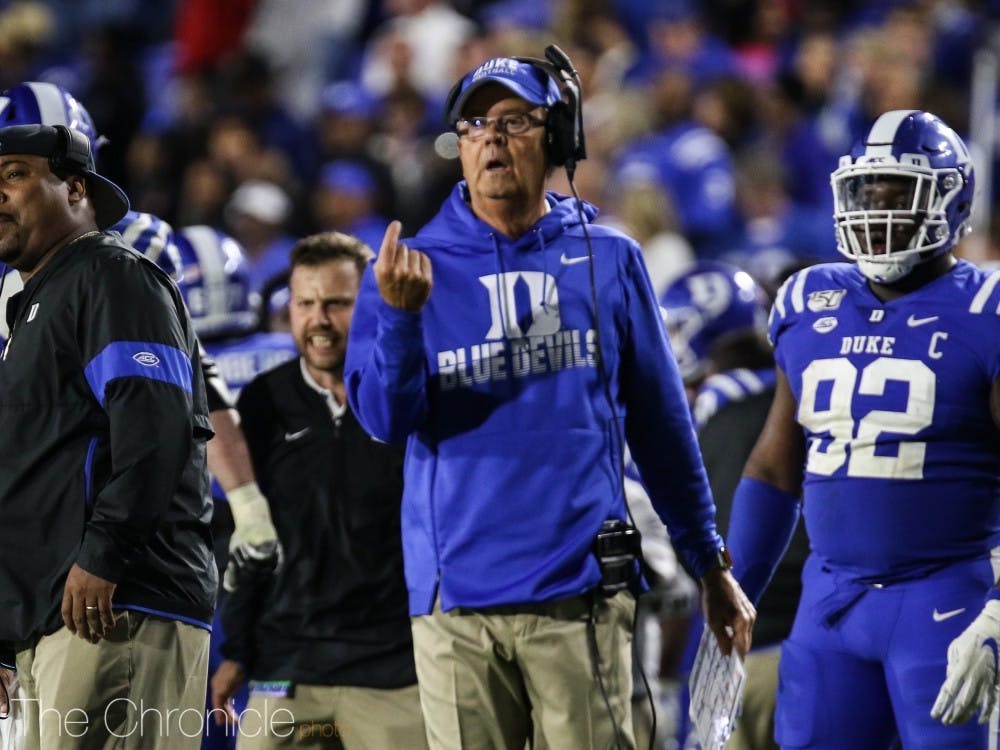Although Duke lost its seventh game of the season Saturday against Wake Forest, ensuring a losing record for David Cutcliffe's squad, the team could still make a bowl game. The Chronicle takes a closer took into how the Blue Devils could benefit from a rarely mentioned metric: the Academic Progress Rate.
I thought bowl games were only for teams with non-losing records. How can Duke still make a bowl game?
Bowl games were once reserved for top-tier teams. Fifty years ago, there were only 11 total bowl games, with only a handful of the 22 competing teams entering the postseason with less than eight wins. As college football has become a more lucrative sport financially, however, more and more bowls have emerged. Today, December and January include 41 separate bowls.
This figure is somewhat misleading in terms of potential slots, as it incorporates the College Football Playoff national championship as well as the Celebration Bowl, which is designated for two FCS teams. In other words, the NCAA actually has room for 78 of the 130 FBS teams.
Generally speaking, if a team finishes a season with a non-losing record, it will make a bowl. For teams other than Hawai’i and opponents that opt to use the Hawai’i Exemption, this means winning at least six games, with at least five coming against FBS opponents. If more than 78 teams finish with non-losing records, then the NCAA rejects the extra teams with the weakest schedules, which happened to the Louisiana-Monroe, Miami (Ohio), Southern Mississippi, and Wyoming squads in 2018. In contrast, if fewer than 78 teams win six games, then the NCAA turns to a variety of metrics to fill the additional slots.
First selected are teams that won six games, only four of which came against FBS opponents. Next are those who used the Hawai’i Exemption and went 6-7. Finally, the NCAA looks at a school’s Academic Progress Rate. Schools receive two points for each student on an athletic scholarship who is enrolled in school and remains eligible in terms of academic standing. For D1 athletes, this means having a 1.8 GPA as a freshman, a 1.9 GPA as a sophomore, and then finishing the last two semesters with at least a 2.0 GPA. The teams with the highest amount of points are ranked accordingly and given preference to open bowl slots. The last time APR was used was 2016, when both Mississippi State and North Texas were able to salvage 5-7 regular seasons due to university athletes’ strong performance in the classroom.
Where does Duke stand in APR?
Very strong. Duke sits at a tie for third in APR nationally at 992 points, trailing only Air Force (997) and Northwestern (996) and deadlocked with Clemson (992). Air Force and Clemson have both already qualified for bowl games and will not need to rely on APR. Northwestern is struggling through a rebuilding year and, at 2-9, is a few wins short of a bowl even with a strong APR.
What would it take for Duke to secure a bowl game?
72 teams have already qualified for bowls, leaving six slots for the rest of the nation. Two teams are in unique situations. Liberty is 6-5, but two of those wins came against FCS teams, so the Flames must win this weekend to become officially bowl-eligible. Even if Liberty does not beat 2-9 New Mexico State for the second time this season, the Flames will still slot ahead of Duke in terms of bowl preference even with a loss. Currently at 5-6, Army jumps ahead of Duke in terms of preference if it wins one of its final two games, but both of its remaining games, against 8-4 Hawai’i (in Honolulu) and 8-2 Navy (in neutral-site Philadelphia), present significant hurdles and make Army unlikely to reach six wins.
13 teams enter the final weekend at 5-6, meaning that only four can win for Duke to have a chance (assuming a Liberty win and two Army losses).
One of these 14 may not even be bowl-eligible, as Missouri is facing a potential one-year ban due to academic fraud. The NCAA has not yet ruled on the Tigers’ appeal, but let’s assume for the sake of argument that Missouri must sit out this year.
Ohio (playing 0-11 Akron), Michigan State (playing 3-8 Maryland) and North Carolina (playing 4-7 North Carolina State) are favorites. Conversely, Nebraska (facing No. 17 Iowa), Troy (facing No. 22 Appalachian State), Oregon State (facing No. 14 Oregon), Colorado (facing No. 6 Utah), and Louisiana-Monroe (facing 9-2 Louisiana) are significant underdogs.
That leaves four teams as toss-ups: Boston College (on the road against 7-4 Pittsburgh), Kent State (on the road against 6-5 Eastern Michigan), Mississippi State (at home against rival 4-7 Mississippi) and TCU (home versus 4-7 West Virginia).
Any chance that Duke has at reaching a bowl game, though, begins with a victory of its own against Miami Saturday. The Blue Devils are 2-9 against the Hurricanes under Cutcliffe, with Duke coincidentally securing last year’s bowl eligibility in a 20-12 victory at Hard Rock Stadium.
Correction: A previous version of this article stated that Duke is 9-2 against Miami during David Cutcliffe's tenure, not 2-9. The Chronicle regrets the error.
Get The Chronicle straight to your inbox
Signup for our weekly newsletter. Cancel at any time.

